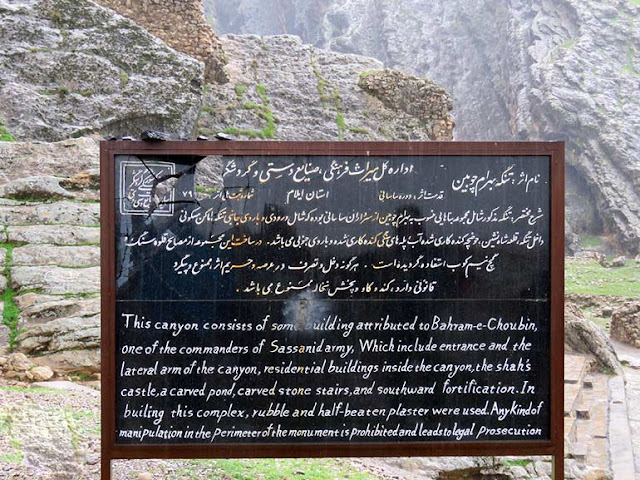Bahram Choobin (بهرام چوبین) was a nobleman, general, and political leader of the late Sasanian Empire and briefly its ruler as Bahram VI (r. 590-591). He was a member of the House of Mihran, one of the seven Great Houses of Iran. The family was of Parthian origin, and was centered in Ray, south of Tehran. Bahram earned an elevated position in Iran due to his noble descent, character, skills, and accomplishments.
Bahram Choobin originally started his career as margrave of Ray, but in 572 he commanded a cavalry force and took part in the siege and capture of the key Byzantine stronghold of Dara and was promoted to army chief of the "North". After being promoted he fought a long, indecisive campaign in 572–591 against the Byzantines in northern Mesopotamia. In 588, the Turkic Khagan Bagha Qaghan (known as Saba in Persian sources) invaded the Sasanian territories south of the Oxus, where they attacked and routed the Sasanian soldiers stationed in Balkh, and then proceeded to conquer the city along with Talaqan, Badghis, and Herat. Bahram was chosen to lead an army against them and was given the governorship of Khorasan. Bahram's army supposedly consisted of 12,000 hand-picked horsemen.
His army ambushed a large army of Turks and Hephthalites, re-conquering Balkh, where Bahram captured the Turkic treasury and the golden throne of the Khagan. He then proceeded to cross the Oxus river and won a decisive victory over Turks, personally killing Bagha Qaghan with an arrowshot. He managed to reach as far as Baykand, near Bukhara. The Sasanians now held suzerainty over the Sogdian cities of Chach and Samarkand, where Hormizd, the Sassanian King, minted coins.
After his victory against the Turks, Bahram was sent to Caucasus to repel an invasion of nomads, possibly the Khazars, where he was victorious. He was later made commander of the Sasanian forces against the Byzantines once again, and successfully defeated a Byzantine force in Georgia. However, he afterwards suffered a minor defeat by a Byzantine army on the banks of the Aras.
It is said that Bahram was the subject of jealousy after his victory against the Turks. Hormizd's minister Azen Gushnasp, who was reportedly jealous of Bahram, accused him of having kept the best part of the booty for himself and only sending a small part to Hormizd. Hormizd could not tolerate the rising fame of Bahram, and thus had him disgraced and removed from the Sasanian office. Furthermore, Hormizd also sent him a chain and a spindle to show that he considered him a lowly slave.
Enraged, Bahram, who was still in the east, rebelled against Hormizd and due to his noble status and great military knowledge, was joined by his soldiers and many others as he set for Ctesiphon. This marked the first time in Sasanian history that a Parthian dynast challenged the legitimacy of the Sasanian family by rebelling. A palace coup under Hormizd’s two brothers occurred in Ctesiphon, which resulted in the blinding and ultimate murder of Hormizd. During the rebellion Bahram took refuge in a gorge in the Zagros Mountains near present day Ilam province which is now appropriately named Bahram Choobin Gorge.
Bahram eventually reached the Nahravan Canal near Ctesiphon, where he fought the King's men and defeated their forces and Ctesiphon fell to Bahram. Bahram declared himself king of kings in the summer of 590, asserting that the first Sasanian king Ardashir I (r. 224–242) had usurped the throne of the Parthian Empire, and that he now was restoring their rule. Bahram tried to support his cause with the Zoroastrian apocalyptic belief that by the end of Zoroaster's millennium, chaos and destructive wars with the Hephthalites/Huns and the Romans occurs and then a savior would appear.
Khosrow II, son of Hormizd, had ascended to the Sasanian throne and clashed with Bahram. As Bahram captured Ctesiphon, Khosrow II fled to the Byzantine Empire, with the assistance of which he launched a campaign against Bahram, who was defeated with his outnumbered forces, but managed to flee to the Western Turkic Khaganate where he was well received. He was assassinated shortly thereafter at the instigation of Khosrow II, who could not feel safe as long as Bahram lived.

.jpg)





No comments:
Post a Comment